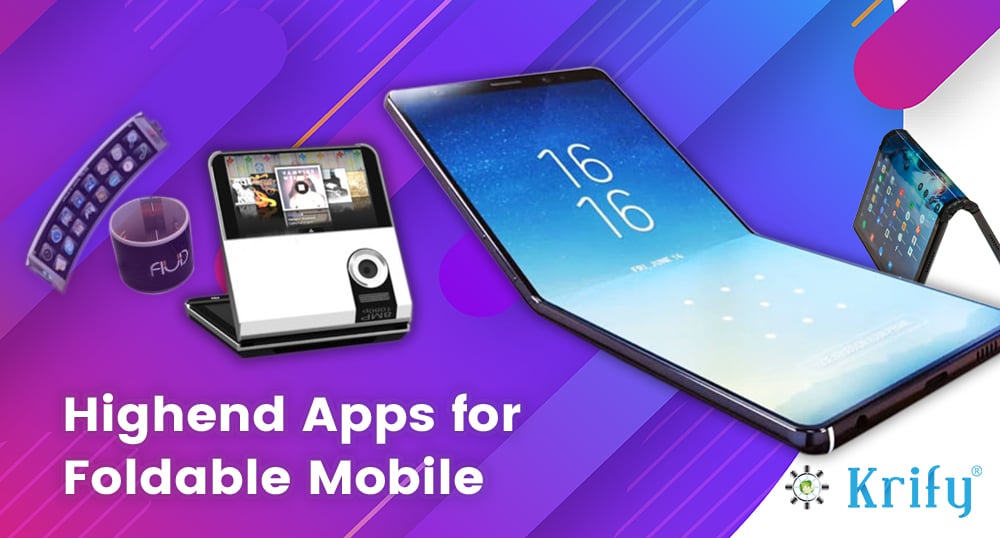Mobile phones come in various shapes and sizes, driving device makers to standardize around flat glass slabs. But we could be looking at another big shift in smartphone design, Samsung has come up with new form factors devices — “Foldable Phones”. Smartphones revolutionized life in the past decade, altering communication and thinking patterns while creating opportunities for developers. Now the new Galaxy Fold bringing a new way to work and likely to be a new game changer along with the rise in foldable mobile app development.
Samsung unveiled technology for foldable, rollable, and stretchable screens, sparking interest in app developers’ approach to foldable apps. And every app owner should give a thought “is your app ready for the foldable phones?” Google announced that it is optimising its operating system to prepare the apps for multi-window in Android to seamlessly adapt to different screen sizes i.e you may think that the device as both a phone and a tablet and foldable devices. The UI/UX design is crucial for these devices, requiring uniqueness even when folded or unfolded.
Here are the set of recommendations and information for foldable mobile app development for Samsung’s foldable phones in order to provide a great user experience.
Awesome Features of Foldable Smartphone Device
App Continuity
Users will be in a state to manage multiple displays on one mobile device. Your application will be able to transition from one screen to another automatically. Apps will adapt to different screens, seamlessly transitioning to suit user preferences as they switch between them. The apps needed for creating multi-screen support Android app. For this transition, your app will receive a configuration change for the new layout so as to provide a great user experience when switching from one screen to the other, you must make sure your app properly support runtime configuration change and proceed with foldable mobile app development for multiple screens.
How to Test:
Now, Android App Developers can check how a normal app going to look on Samsung’s wild foldable phone which enables them to verify that it was done properly by using an emulation situation that is equipped for app continuity. The emulator app, compatible with AVD (Android Virtual Device) in Android Studio and Android tablets, facilitates testing for varying screen sizes.
Multi-Window
Beginning from API level 26, the platform offers enhanced support for application development for multi-screen solutions. If an activity is switching to a large screen such as foldable phone case, the users can use more than two split-screen modes. There may be instances that the app may stop functioning whenever there is a move one to another. In order to mitigate this, Multiscreen solutions are introduced in this foldable phones where if an activity supports multi-window mode and is running on a device with multiple displays users can move the activity from one display to another easily this is done when the activity has launched in an app, the app can specify which display should run.
How to Test
Just try it out by using the developer options, simulate secondary displays option. Also, remember that those simulated displays do not process inputs.
Are you looking for Multiscreen Application development company in India to prepare your apps for multi-window in Android. Krify is here to guide you in the best way to get your app ready for foldable technology.
Multi- Resume
In general, when the app is in multi-window but not focused, then it will be on the OnPause state. While recommending support for multi-window, we observed that many apps do not support the OnPause state. In order to help developers provided the best user experience on multi-window with minimal effort, allows the device manufacturers to keep all the apps resumed even in the multi-windows in Android p. To get this option in Android p you need to add the meta-data in your app-manifest:
“<meta-data android:name=”android.allow_multiple_resumed_activities” android:value=”true” />”
Infinity Flex Display
Galaxy Fold takes the display game to the next level with the use of Infinity Flex display. This is the first prototype of a foldable display. It is the world’s first dynamic AMOLED display and is based on the AMOLED technology. They claim to have developed a proprietary polymer for the display, making it 50% thinner while maintaining durability.
Unique and durable Hinges
The next best feature is the hinge mechanism. The hinge mechanism solved the too bulky for the device, enhanced the durability and make the device look great. These hinges are slim and integrate with the rear making if flat when used in the tablet mode. The device gets multiple interlocking gears that assure a smooth and stepped folding of the smartphone. The rear view resembles an S-Pen stowed between the tablet, with the hinge mechanism designed to withstand at least 100,000 folds.
Three Camera Setups
The Galaxy Fold is the first phone to feature a 6-camera setup, including triple, dual, and single configurations. When unfolded, it boasts a dual front camera setup with a 10MP primary sensor (f/2.2 aperture) and an 8MP secondary sensor for depth sensing (f/1.9 aperture). In folded mode at the front, it has a 10MP camera within the notch with f/2.
Krify being an innovative app development company, we have emerged with a future rich mindset for design and development of mobile apps. Inquire us to build your first foldable mobile app. A great example of our passion is gadgets we own and our team go two first launched foldable mobiles is in Krify Testing Labs to make the future of the app compatible.



